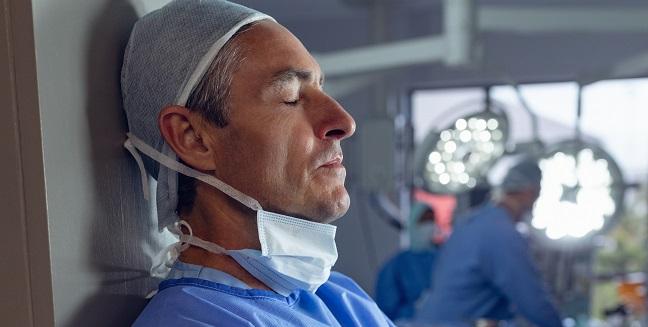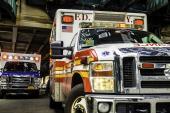As Cardiac Surgery Volumes Fell in Early COVID-19, Deaths Climbed
Case volume drops were largest in New England and the mid-Atlantic regions hit hardest in the initial months of the pandemic.

Plummeting procedure numbers were matched by a chilling spike in observed versus expected mortality, hinting that surgeons were dealing with later presentations, more complex procedures, and hospital-related challenges.
Other studies looking at the early weeks and months of COVID-19, when hospitals services were shut down or severely limited and patients proved reluctant to seek care, have documented widespread cardiac impact including missing STEMIs, increased rates of cardiac arrest, and fewer diagnostic and elective procedures.
As such, a dip in case volume for cardiac surgeries through June 2020 was no surprise, according to Tom Nguyen, MD (University of California, San Francisco), who presented the findings on Saturday at the virtual STS meeting.
What was interesting, however, is that “eventually when the initial first storm ended and we were kind of out of the woods a little bit, most of the programs across the country . . . almost reached back to normal but didn’t go above normal,” he told TCTMD. “So there was definitely a COVID-induced deficit, but then after the surge, you don't see an increase. Somewhere out there in the United States there are people who probably should have been operated on and they never were.”
For the study, Nguyen and colleagues included surgical data from 717,103 patients in the STS Adult Cardiac Surgery Database who underwent cardiac operations between January 2018 and June 2020. They observed a 53% reduction in the average monthly cardiac surgical volume after the pandemic was declared, including a 65% decrease in elective and a 40% drop in nonelective cases. The first decrease in services, observed in April 2020, coincided with the first spike in COVID-19 cases, as documented in a Johns Hopkins database.
Regionally, New England hospitals saw a 63% reduction in total cases while those in the mid-Atlantic reported a 71% drop. In a subgroup analysis focused on the mid-Atlantic region, elective and nonelective cases fell by 75% and 59%, respectively.
Somewhere out there in the United States there are people who probably should have been operated on and they never were. Tom Nguyen
As for what might be causing the additional mortality risk, he said it’s multifactorial, though COVID-19 infections may have played a role. “We know from a pathophysiologic standpoint, there is a sequalae of COVID on the microvascular and pulmonary system,” Nguyen said. “So, there’s something inherent with the pathology of operating on a COVID-positive patient that would definitely affect the outcomes.”
But also, the healthcare system wasn’t prepared, he added. “We were strained with staffing, with availability of [personal protective equipment], surgeon availability, how to mobilize forces, who to operate on. [With surgery], any one little wrench can throw things off and fail a system, and COVID was like a gazillion wrenches that just threw out the normal cadence of the way things were done.”
Several Consequences
A major consequence of the pandemic, Nguyen said, is that cardiac surgeons—like interventional cardiologists—are seeing late presentations of untreated disease processes “that we haven’t seen in years.” For example, postinfarct ventricular septal defect is “something that most surgeons haven’t dealt with for a while and aren’t probably prepared to deal with,” he observed. “This is something that was a little more prevalent 15-20 years ago, give or take, but surgeons who graduated 10 years ago probably have never seen it. . . . So, how do you manage it?”
Training has also been “hugely” impacted, he continued. “That COVID-induced deficit in case volume has resulted in a COVID-induced deficit in case volume for trainees also, [and] the number of trainees hasn’t changed. What we need to do is increasingly be more efficient about training. This has forced us to be even more efficient about making sure you get the most bang for your buck in every second you have in the operating room, every second we have with patient encounters, and every second we have with attendings—but it’s tough.”
Discussing the study following Nguyen’s presentation, Vivek Rao, MD (University of Toronto, Canada), said he performed a similar analysis in Ontario, Canada, that observed similar patterns. “While we all expected a flood of patients to return as we returned to normal activity in the fall of 2020, this did not occur,” he said. “In fact, right through to November 2020, we never quite achieved our prepandemic volume. Which begs the question: what happened to those hundreds if not thousands of patients that didn't seek cardiac surgery during the height of the first wave of the pandemic? The sad fact is many of those simply died while awaiting hospital care for their cardiac disease.”
Studies like these “highlight the fact that cardiac disease remains an important killer of men and women in North America which should not be obfuscated by the pandemic that we're currently in,” he stressed.
“You only know what’s wrong unless you know it’s wrong,” Nguyen said. “So now we know the issues. We are more prepared to understand the consequence of COVID, and now we know what we need to look at to mitigate the reduction in volume and improve the outcomes.”
Nguyen and colleagues plan to continue studying the STS data as they come in, hopefully with even more granularity, he said.
Echoing a message cardiologists and emergency physicians have been trying to get out for months, Robbin G. Cohen, MD (University of Southern California, Los Angeles), who was not directly involved with this study, stressed: “These numbers should not serve as a deterrent to patients seeking care for chest pain or other cardiac symptoms.”
If anything,” Cohen said in a press release, “they are a warning to get into the system as soon as possible.”
Yael L. Maxwell is Senior Medical Journalist for TCTMD and Section Editor of TCTMD's Fellows Forum. She served as the inaugural…
Read Full BioSources
Nguyen TC. The effect of COVID-19 on adult cardiac surgery in the United States: analysis of the Society of Thoracic Surgeons adult cardiac surgery database. Presented at: STS 2021. January 30, 2021.
Disclosures
- Nguyen reports serving as a speaker for Edwards Lifesciences, CryoLife, and Abbott.





Comments